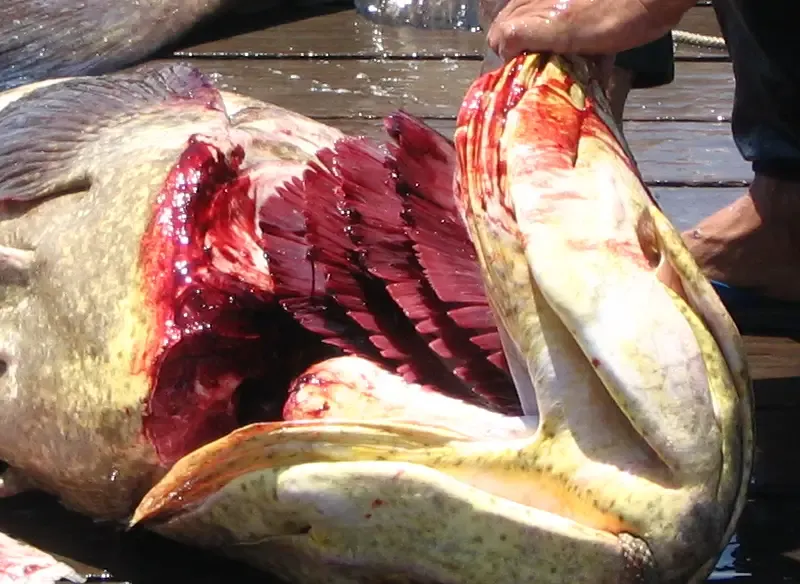There is no real right or wrong way to properly bleed a fish as long as it is done. You should try several ways to find the one that works best for you. However, the easiest method to bleed a fish is by cutting the gills.
Why You Need to Bleed a Fish
Bleeding a fish refers to the process of removing blood from the fish’s body soon after it is caught. It is a common practice in fishing for several reasons:
Preservation of Meat Quality
Bleeding a fish helps improve the quality and taste of the meat. When a fish is caught, stress and exertion can cause the build-up of lactic acid and other stress hormones into its bloodstream. These hormones can negatively affect the flavor and texture of the fish meat, resulting in a “fishy” or bitter taste.
By bleeding the fish, you remove the blood and these undesirable compounds, resulting in better-tasting meat.
Improved Appearance
Bleeding a fish can also enhance the visual appeal of the fish fillets. Blood in the flesh can cause discoloration, giving the meat an unappetizing appearance.
By bleeding the fish, you help maintain the natural color and appearance of the fillets, making them more visually appealing.
Hygiene and Food Safety
Bleeding a fish helps remove potential bacteria and toxins that may be present in the blood.
Removing the blood reduces the risk of bacterial growth and contamination, contributing to better food safety.
Do You Need to Bleed All Types of Fish?
Bleeding fish is not necessary for all species of fish, as the need for bleeding can vary depending on the species and intended use of the fish.
Bleeding is commonly practiced for larger fish species, particularly those that are pelagic (living in open waters). Examples include tuna, swordfish, and some species of shark.
These fish often have darker meat and higher levels of blood, so bleeding helps remove blood and improve the quality and taste of the meat.
Some fish species naturally have darker flesh due to higher myoglobin content. Examples include mackerel, bluefish, and some species of salmon. Bleeding these fish can help reduce the intensity of the fishy flavor and enhance the overall taste.
For fish that will be consumed raw or used for sushi, bleeding is often recommended. This is to ensure the freshest and cleanest flavor and appearance.
Smaller fish species with white flesh, such as flounder, sole, or snapper, generally do not require bleeding. These fish typically have lower blood content and milder flavors, so bleeding is not necessary for quality purposes.
Bleeding fish can be a matter of personal preference. Some anglers and consumers prefer to bleed all types of fish, regardless of species, to ensure the best possible flavor and appearance.
What’s the Best Way to Bleed Out a Fish?
The proper way to bleed a fish is the method that you feel most comfortable using. I recommend the following method:
- You will need a sharp knife, preferably one with a thin and pointed blade, and a container or cooler with ice to keep the fish fresh after bleeding. Alternatively, you can use shears as well.
- Hold the fish firmly to prevent it from moving or flopping around. You can use a wet towel or grip the fish with a glove or cloth for a better grip.
- The gills are the primary area to bleed the fish. Gently lift the operculum (the gill cover) to expose the gills.
- With a swift, firm motion, use the knife to sever the gill arteries on both sides of the fish’s head. The gill arteries are located just above the gills and are visible as a cluster of red blood vessels. Cut them by inserting the knife and making a quick, deep incision.
- Once the gills are cut, place the fish in a bucket of water, cooler or container with ice, with the head tilted downward to allow the blood to drain out. The melting ice will help keep the fish cold while the blood drains.
- While the fish is bleeding, you can prepare for cleaning it by setting up a workspace and gathering the necessary tools for gutting and filleting.
- After the fish has bled out for a few minutes, you can rinse it with clean, cold water to remove any remaining blood or debris. This step is optional but can help improve the appearance of the fish.
- Store the fish properly: Once the bleeding and rinsing are complete, store the fish on ice or in a cooler to maintain its freshness until further processing or consumption.
Check the video below to see the process in detail:
Should You Bleed Fish in Water?
To bleed a fish effectively, I recommended removing it from the water and performing the bleeding process on land or on a boat.
This allows for better control over the bleeding and ensures that the blood is properly drained from the fish’s body.
After bleeding, the fish can be rinsed with clean water, but the actual bleeding process should be done outside of the water.
How Long Should You Bleed a Fish For?
A few minutes (typically 2-5 minutes) of bleeding is enough to remove most of the blood from the fish’s body. During this time, the fish should be positioned with its head down to allow gravity to assist in draining the blood.
How Do You Know When the Fish Has Bled Enough?
One way to assess if bleeding is sufficient is to observe the color of the blood draining from the fish. Initially, the blood may be bright red, but as bleeding progresses, it should become paler or turn pink, indicating that a significant amount of blood has been removed.

Do You Bleed a Fish Straight Away?
Yes, bleeding a fish should ideally be done as soon as possible after catching it. Bleeding the fish immediately after catching fish helps ensure the best quality and flavor of the meat.
The longer you wait to bleed the fish, the more time blood has to circulate through the fish’s body, potentially affecting the taste and texture of the meat.
How Do You Kill a Fish in a Humane Way Before Bleeding It?
Ikejime, also known as brain spiking, is a traditional Japanese method used to humanely kill fish and improve the quality of the meat.
It involves inserting a spike or a thin pointed instrument into the fish’s brain to immediately destroy its central nervous system.
The insertion point is typically just behind and slightly above the fish’s eyes, where the skull is thinnest.



